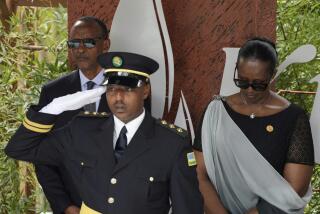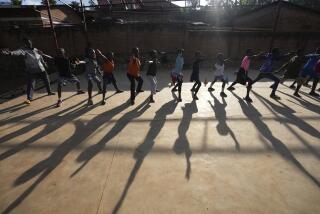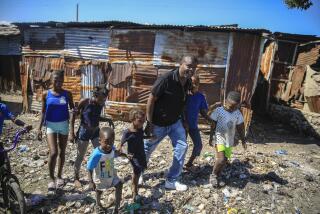West African Victims of 26-Year Reign of Terror Demand Remembrance
- Share via
CONAKRY, Guinea — The prison cells are empty now, the roof torn off for scrap, the doors ripped away. Shaded by leafy trees and walled off from the noise of this ramshackle capital, the abandoned compound is simply a tranquil spot.
Look closely, though, at walls covered with mold and crawling with spiders: Row after row of hash marks have been scratched into the concrete; dates and words have been laboriously carved.
Here, in a prison camp that was once among the most feared places in West Africa, the lives of thousands of people tortured and killed during the brutal 26-year regime of former President Sekou Toure have been reduced to the scrawl of some fading graffiti.
“Arrete,” one man carved, in French, into the wall of his Camp Boiro cell, and the date of his arrest: Sept. 10, 1977. His name, though, and the rest of his message can’t be deciphered. They’ve been lost to the rain and the sun and the mold.
That, say people campaigning to have the victims of Toure’s regime remembered, is precisely what the current government wants.
Thousands Sent to Death Camp
Historical memory is often a battleground. From Japanese textbook entries about World War II to American portrayals of 19th-century Indian wars, many countries furiously debate their violent histories.
In Africa, nations from Nigeria to South Africa are arguing over government-sponsored brutalities of recent decades.
But in Guinea, some people say the question has become whether there should be memories of any sort about Toure’s regime.
“There is a conspiracy to just close the issue and not talk about it,” said Ousmane Diop, a statistician who spent a year at Camp Boiro in the early 1970s and has become an activist for the victims’ cause.
President Lansana Cofte, who seized power in a coup days after Toure died in 1984 and won his second election in mid-December, has created a milder regime than his predecessor’s dictatorship, critics say, but he still remains firmly at the center of power. And there are few things he wants less than to resurrect memories of Toure’s terror.
“They just want to forget it,” Diop said.
Critics say the government is trying to stifle the memories by allowing construction atop a cemetery where prisoners were buried and by refusing to release an accounting of Toure’s brutal purges. The government also has rejected calls to build a monument at Camp Boiro.
Meanwhile, Toure’s former party has been trying to rehabilitate itself, playing down--or simply denying--his atrocities.
The Camp Boiro prison, a 76-cell compound inside a military base, was the most feared symbol of Toure’s government, a one-party Marxist regime that began with the promise of socialist brotherhood but quickly descended into state-encouraged suspicion, imagined plots and mass arrests.
Thousands of Guineans--along with French, Lebanese and other foreigners--were sent to die at Camp Boiro, victims of Toure’s paranoia.
Prisoners were beaten, shocked with electrodes and starved until they confessed to whatever they were accused of. Inmates were locked away during daylight hours and allowed no contact with the outside. Anyone who resisted was sealed in a cell with no food or water, an agonizing death known as the “black diet.”
“If you are clever, you [confess] immediately and write down whatever they want,” said Abdoulaye Diallo, a soft-spoken lawyer who spent nearly 10 years in the prison and still bumps into his torturers in Conakry. “For 2 1/2 years, I never saw the sun--never.”
The camp was just one part of Toure’s terror.
“Everyone was afraid,” said Boubacar Baidy Gueye, a businessman who fled Guinea as a child after his father was arrested. “Husbands were afraid gf wives. Parents were afraid of children. Children were afraid of their brothers and sisters.”
No one is sure how many people died in the purges--estimates range from 6,000 to 35,000--but by Toure’s death about 2 million people had fled the country.
Gueye, whose fury over his father’s death still tears at him, is raising money for a memorial to the dictator’s victims.
“People need to know about this,” he insisted bitterly.
But, instead, Toure’s reign has become a largely forgotten horror in a largely ignored country.
A Reign of Terror, Mismanagement
One of the world’s poorest nations, Guinea achieved independence in 1958 and immediately began its long decline. The French, furious that Guinea was leaving their sphere of influence, destroyed nearly all they had built during colonial rule--everything from power lines to toilets.
Toure, the first president, then sowed terror with ethnic and political witch hunts while he crippled the economy with nationalizations and mismanagement.
Fourteen years after his death, Guinea still faces rampant poverty and nearly four of every five people can’t read or write.
But the country is rebuilding. New buildings have gone up in recent years, and scattered construction projects are in progress.
The political situation has also softened. Purges have ended, newspapers openly criticize the government, and a multi-party presidential election was held Dec. 14. Opposition groups claimed Conte’s latest victory was rigged, but monitors from the U.S. Embassy said the voting process appeared much cleaner than when Conte won in 1993.
Conte’s critics contend, though, that the political openness is largely a facade. They note the president’s reelection campaign was backed with government funds, military support and control of broadcast media.
Despite such accusations, the fear that suffused Conakry during Toure’s time, when secret police stalked every street, has ended.
Government officials, who seldom mention the bloody purges of Toure, declined requests to discuss the political situation or the terror.
The victims, though, say the memories must survive.
“It’s important the young know what happened,” said Aissatou Poredaka Diallo, whose husband died at Camp Boiro. “You have to ask questions about what happened here, so you don’t believe the lies.”
More to Read
Sign up for Essential California
The most important California stories and recommendations in your inbox every morning.
You may occasionally receive promotional content from the Los Angeles Times.













